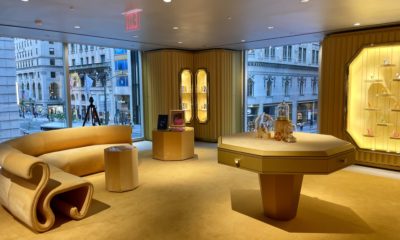Question: Your fundamental job.
“What is 'Pleasing my boss'?” No, wrong answer.
“Pleasing the cfo?” An even worse answer.
(“Pleasing my mother?” You are the weakest link. Good-bye!)
“What is 'Pleasing the shopper'?” Correct! You win the Daily Double.
Advertisement
Not as easy as it sounds, though. Competition for a shrinking dollar is intense. And the shopper in question is finicky, nervous, looking only for bargains and doesn't really want to be in the store. Can you possibly woo her with store design?
These days, it seems, you can. Consider what has become the hottest new design element in store planning: the cashwrap.
We've gone, in a decade, from warm and residential environments; to the craze for retail-tainment; to using technology to lure the Internet generation. And what do today's store planners feel will make the difference between retail success and failure in this murky economy?
Where they put the checkout counters.
When RadioShack opened its new prototype in Fort Worth this summer, it seemed most proud of having moved the cash registers to the middle of the store.
Kohl's, the darling of the bear market, has been lauded for putting the checkout counters near the doors.
Advertisement
A year ago, Federated began testing a smaller Bon Marche prototype in Montana – a Kohl's-like 65,000-square-foot strip center store with one entrance and supermarket-style checkouts.
Look at Federated 's new Lazarus store in Columbus, Ohio. A comfortable place for husbands or boyfriends to watch football. An area for kids to play. Shopping carts for large purchases. And conveniently placed checkout stations.
It's all to please the shopper.
Forget the plasma screens and kiosks. Do you know what interactives will best capture shoppers'attention? Price checkers that read tags and tell people what an item really costs. Partly, it's the Nine Circles of Markdowns that has become commonplace in this economy. And partly, it's the faltering eyesight of the baby boomers. Fifty-somethings can't see the price tags anymore. If you want this still-most-influential land mass of instant-gratification consumers in your store, make it easier for them to see what they're buying.
Kohl's, Target and Federated are all expected to have these scanners scattered throughout the majority of their stores by Thanksgiving.
At the other end of the spectrum from the boomers are the teens and tweens, who spend hours pre-shopping on the Internet. When they get to the store, they know exactly what they need and want and are impatient with clutter, confusion and obstruction. So the shopping experience has to be as efficient and attractive as they demand, but still introduce opportunities for impulse purchases.
Advertisement
Also keep in mind that while they'll sit for hours reading each other's e-mails – : ) – out in public they have the attention span of a fruit fly. But, like the boomers, they have money to spend, and want to spend it. So they, too, have to be pleased.
The Dow, Nasdaq and the S&P have all plummeted. And who remembers same-store sales increases anymore? It's Final Jeopardy time. You don't need Alex Trebek to tell you to think carefully before you respond.
Remember to put your answer in the form of a question. And bet wisely.

 Headlines2 weeks ago
Headlines2 weeks ago
 Headlines1 week ago
Headlines1 week ago
 Headlines2 weeks ago
Headlines2 weeks ago
 Headlines5 days ago
Headlines5 days ago
 Headlines1 week ago
Headlines1 week ago
 Eric Feigenbaum3 days ago
Eric Feigenbaum3 days ago
 Designer Dozen1 week ago
Designer Dozen1 week ago














